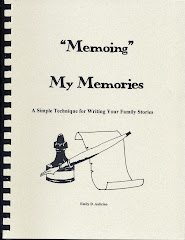Writing prompts, like most things in life, come in a variety of packages. Basically, there are three types: The Good, The Bad, and The Ugly. Rather than tell you about these different styles of prompts, the following is written as an experiment to show you how well each works.
To take those three types of prompts in reverse, I’ll start with…
The Ugly
Most of us do not consider all the previous topics I have posted on this blog when we begin to write our family stories and childhood memories. Frankly, knowing about Getting Started, Timelines, Writer’s Block, Organizing Your Stories, Revising, Point of View, etc. is not necessary for you to write a wonderful selection of stories for your descendants. You only need to begin with any memory that your recall.
SO…let’s begin with that memory….
Well? Have you written on that memory? Could you think of a memory or are you still deciding upon which one to write? Was that ugly or what? Imagine doing that for all your childhood stories. How quickly would you get discouraged?
The Bad
Ok, now, let’s try this experiment. For the remainder of this article, do each step as you read it. Do not look ahead as you will only cheat yourself. Try this little test, and allow me show you the differences between writing prompts and how they affect your stories.
First, take a couple sheets of paper, your favorite writing tool, and a clock or timer.
Next, set your timer for two minutes or watch a clock, if possible, while you write.
Write any and everything that comes to mind for the next two minutes on the prompt below. Write down whatever you are thinking, even if it is not on-topic. You may have to write that you cannot think of anything.
PROMPT: Write about a time when you were a child in your neighborhood.
Stop when you reach two minutes.
Were you able to choose a story quickly or did you spend much of the time thinking? How much did you write?
The Good
Read the following prompt and do the suggested drawing. Then proceed to write your story. After you have written, answer the questions below the prompt.
“Memoing” My Memories Topic 8: The Neighborhood
It is time to focus on your neighborhood as a child and the activities and the events surrounding it. No doubt this could result in countless stories, so we will start with a great brainstorming technique to give you the bases for future writings, as well.
If you lived in more than one home, pick one for now, but try this with all of them, if you can. A neighborhood could just be the block on which you lived or the few houses surrounding your rural home.
First, think back to what your neighborhood was like. Was it rural, urban, or suburban? Did you live in a large or small town, in the middle of the city or on the perimeter?
Who were the neighbors? Can you remember their names? Which houses were theirs?
Was there a unique member of your neighborhood...a kind person who asked you to do errands and tipped you enough for a candy bar or ice cream...a grouchy person whose yard often harbored your baseball or balsa wood airplane...the person whom no one knew well…? Was there a bully on the block? (Even if it was YOU!)
What games did you play in the street or yards with neighbor kids? What games differed from the summer through the winter? Where did you play—a vacant lot, the end of the street, a particular yard? Did everyone get along?
After thinking about these things, draw a map of your childhood street. Add some features unique to each house and the names of the people in the houses. Now choose an event centered on this area and write. Be certain to jot down other ideas on which to write later. There is no doubt many great stories to tell….
©Aulicino, 2003
Questions:
1. For the last exercise were you able to start writing within two minutes of completing your neighborhood map?
2. Which prompt produced the most ideas for writing?
3. By drawing the map of your neighborhood did you recall more events than with the first prompt?
4. Was it more difficult to write a story with the second prompt as you may have had many ideas?
5. Which method do you feel would be more beneficial to you in writing your childhood stories for your descendants?
Summary
The ugly business of trying to write your memories as they pop into your head is quite difficult given the busy lives we conduct. Perhaps memories might be triggered by events in our daily activities, but by the time we sit down to write, they may be gone. Often, by waiting until story ideas occur to us, we are apt to tend to other needs in life.
There are many, many bad prompts in books and on the internet. Many of us have received books from our children or grandchildren with these types of prompts and a lined page on which to write. Few people start these books and even fewer complete them. This type of one-line prompt can be useful, but lacks enough stimuli to assist people in writing quickly. You waste precious time “thinking” about a prompt when you could be writing.
The good prompts are those which do not waste your time, which provide suggestions to stimulate your memory, and which give you more than one idea for a story. This often cannot be done with one-sentence prompts.
The above prompt, The Neighborhood, is from my booklet “Memoing” My Memories which is available for sale. This booklet has 130 prompts using this detailed style to assist you in recalling your family stories and childhood memories. Although there are only 130 prompts, they are written to provide you with many more story ideas for each topic. The booklet also contains organizational tips, information on how to write a timeline when you do not have time to write longer stories, ideas for improving verbs and sentence structure, and some general writing tips. The booklet is spiral bound with a heavy cardstock cover and 70 pound Vellum pages.
Contact me directly at aulicino@hevanet.com to purchase this booklet.
©aulicino, 26 Oct 2008








No comments:
Post a Comment